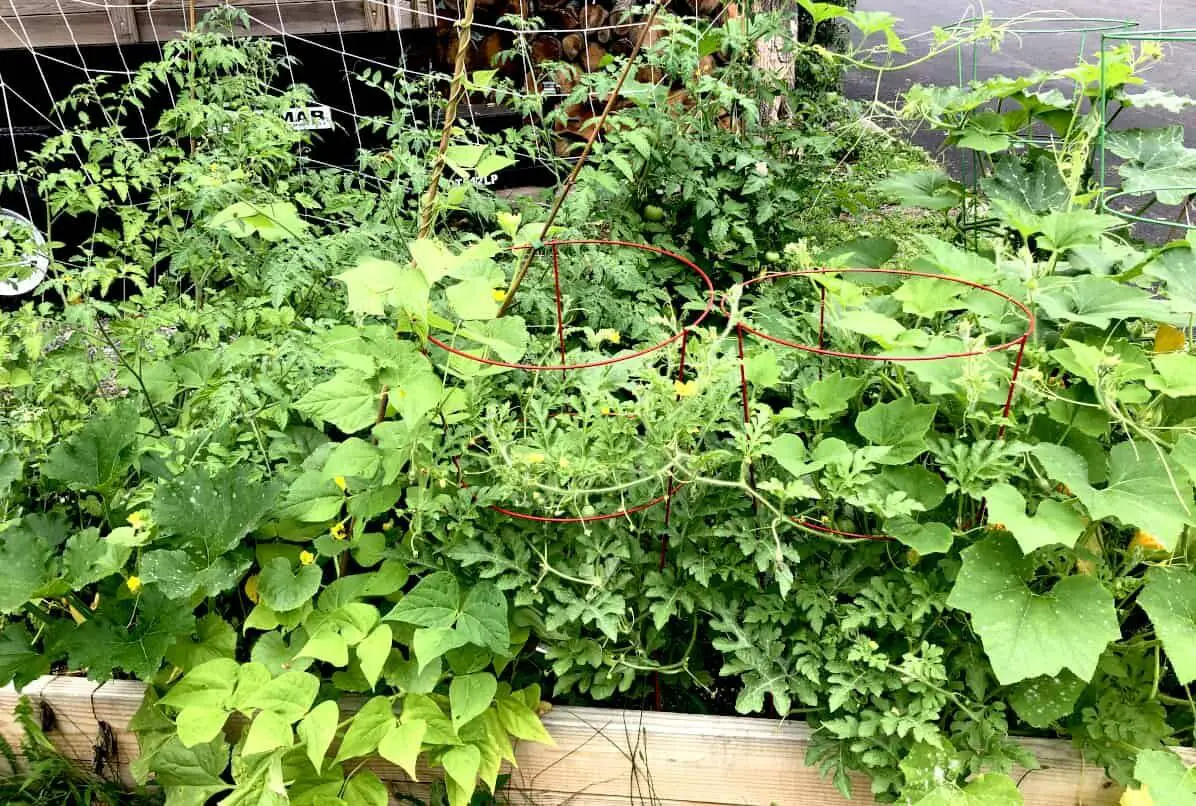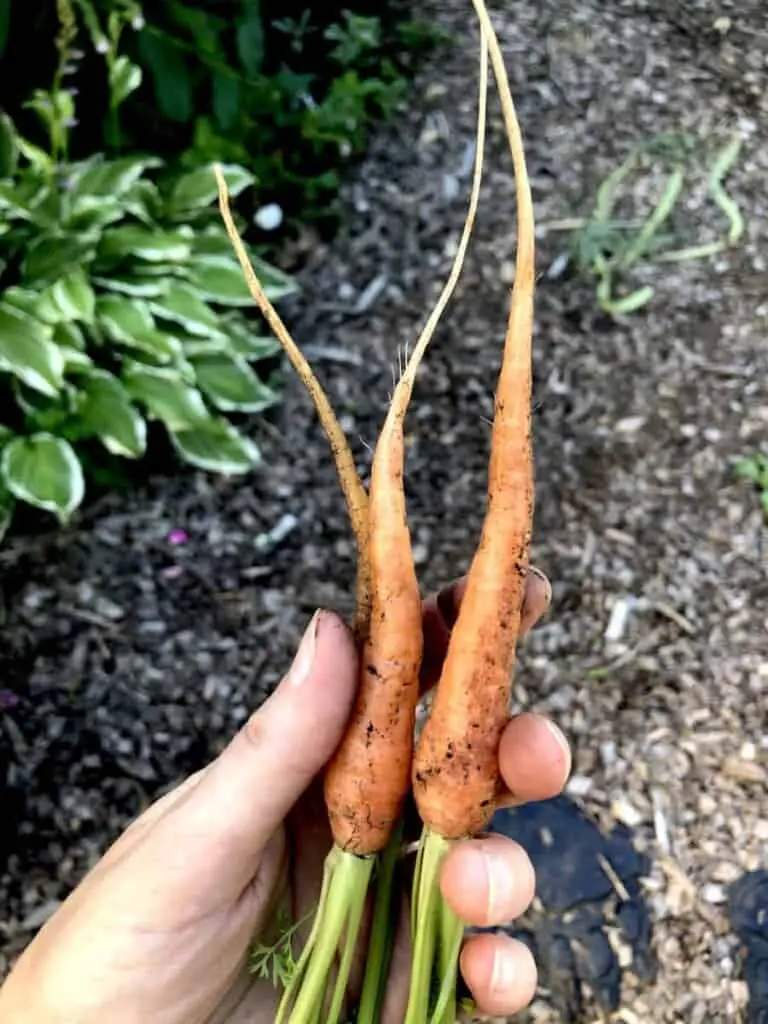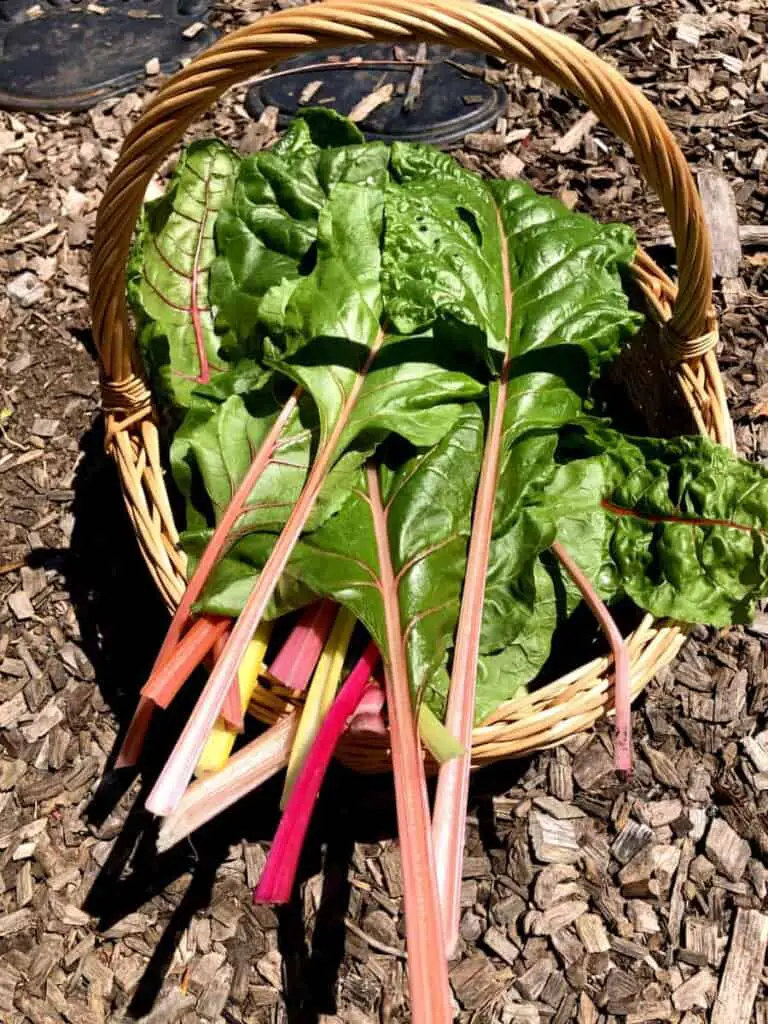A pantry-focused garden helped me to enjoy my gardening experience and focus to provide food for my loved ones. If you are overwhelmed by a large number of varieties of crops to choose from, let me help you to navigate what exact crops to pick for your garden.
A pantry stocking garden or a pantry staple garden is a growing space in which you grow produce like vegetables, fruits, and herbs with the goal to feed your family, to store and preserve the food you have grown. It is a garden with the purpose to fill your cupboards, cellar, freezer, and pantry with homegrown nutritious food your family will enjoy throughout the year. A pantry stocking garden is also called a food garden, a self-sufficient garden, or a pantry staple garden.

One year I planted too many kinds of vegetables and didn’t plan my produce with the focus to fill my pantry. I learned that year that by planting too many varieties I had yields ripened at different times, and not enough of any kind to be preserved or stored in larger quantities. The whole growing season was wasted. I wasn’t a happy gardener, but surely, I became a wiser one. I realized that I have to grow a smaller number of varieties to get a larger amount of yield from each. Instead of growing 30-40 varieties, I only need to focus on 10-15 varieties and let them take over the garden and yield a sustainable amount that I can fill my pantry with.
Why should I grow a pantry-focused garden?
My growing space is very small and limited. Another challenge in my gardening endeavor is that the property is situated at the foot of the hill and I had to spread our garden into several disjointed areas. My gardening space is not one continuous space, but rather a cluster of growing spaces divided by a driveway, a house, and let’s not forget an elevation increase. Even though my garden is a challenge on so many levels, I am very thankful I have my own piece of ground to work and harvest from. We need the wisdom to work smarter, not harder. Work with what you have. If you only have a small balcony or patio, make it work. If you only have a rental where you can do only pots or grow bags on the side of the house, make it work. Again, work with whatever you have available. If you have nothing at all, look for a community garden, a public library garden, or look for a public space you could turn into an edible landscape.

Gardening is a constant learning and discovery. Every year I learn something new, sometimes from my mistakes, other times from mistakes made by others. Many times, I learn from other gardeners who have walked the walk before me.
I started to grow a pantry stocking garden to prevent food shortages and provide food security for my family. I grow with the purpose to provide for my family and that gives me more inner peace.
As a mother, I wish to educate my little one on where the food comes from, especially vegetables, fruits, and products made from them. My garden is a classroom for the whole family, neighbors, and friends.
Another reason to grow a pantry stocking garden is that you will be able to learn survival skill-growing food. One does not become skillful overnight. It is not possible to learn any skill just by watching videos, reading books, or hearing others talk about it, but by active doing, by making mistakes and learning from them. We become skillful by learning from our success as well. We can survive when we have food and water. By learning how to provide food for ourselves we become more self-sufficient and have a better chance of survival. Gardening is a life skill that is gained by doing and learning in the process.
My little one likes to eat fresh vegetables he helps me grow. If you have children, I recommend vegetables such as peas, and carrots, herbs like mint and stevia, and fruit like berries to grow in your space. They are ready to be picked and eaten fresh without cooking or extra preparation. While playing, my little one often picks fresh mint with his hands and eats it just because he walks right by it and smells it. He often picks pods of fresh peas because its sweet and ready to be eaten without washing. He loves to find out how big a carrot is underground and loves to pull it. Once he pulls a baby one that is sweet, he likes to eat it. He is not allowed to pull out if he doesn’t eat it. His curiosity drives him to discover and eat. Children will discover colors, flavors, and where their food comes from, and appreciate how precious food is once they see how much effort goes into it. Raising your children, you are raising a new generation, wisdom needs to be passed down.
Grow your food for health and nutrition reasons. My growing space is strictly organic. I do not use any chemical fertilizers, or chemical pest protection. I am able to grow food that is without harmful chemicals, I can control how healthy and nutritious food we eat. I like to have the power of being able to control what we eat. I am grateful for all the produce we are able to buy from the stores, however, I know that in many cases produce is harvested not in its prime ripe time and thus does not contain its fullest nutritious potential. Some nutrition is also lost during transportation, shipping, and storage. By growing your food, you know what you eat, you know it’s harm free.
Grow a garden for physical and mental health. By caring for your plants, you will get lots of physical activity. Gardeners use their whole bodies, hands, and feet to get things done, lift things, bend, or reach for something. Gardening demands physical activity and is in a way an exercise. When we move, we are happier. I call my garden my office, my classroom where I learn and teach, but also my place to relax and pray. When I garden, I listen to lots of Bible expository sermons. I grow spiritually and I relax by realizing many things. It is a time when I can clear my head, it is also my therapy room.
By being outside in the sun, you get to breathe fresh air, you get vitamin D from the sun, and you get to move. Your body and mind become healthier. I garden for mental refreshment and enjoyment; it is my hobby.
If you are able to learn from your mistakes rather than let them frustrate you, gardening will become a stress-lowering activity for you.
What should I plant in my pantry-filling garden?
I quickly learned that I should not grow produce we don’t like to eat. Simply grow food your family enjoys eating. It is fairly easy to discover what produce is your family’s favorite. Look at what is on your plate. Deconstruct your meal and you will see what your family likes to eat. Do your children like spaghetti with tomato sauce? Then look at the jar your sauce came from and read the ingredients. Perhaps you will find that tomatoes are in the sauce along with onions, garlic, pepper, and carrots.

Does your family enjoy pizza? Look at the toppings, and grow what you like to put on top of your pie, including the sauce.
Another foolproof way to find out what produce your family likes to eat is to check your grocery bags. What is in your grocery bags when you come home from the store? Grow what you pay for the most. If it’s carrots you buy often, then carrots should be in your pantry garden. If you buy lots of broccoli, then you know that you need to grow broccoli. If it’s a tomato that you buy all the time or greens in your salad, that’s what you should include in a pantry stocking garden. You know that you would have to buy it anyway so why not grow it? If you learn how to grow the food you eat, your shopping budget will be lower.
You just discovered what vegetables you need to grow. Now you have the know-how to find out what your family likes and that’s what you should grow in your own pantry stocking garden.
When choosing pantry staples to grow, there are a couple of other factors that need to be taken into consideration. For example, factors like how easy or difficult is it to grow, how well it stores, does it store raw or do you need to preserve it by canning, fermenting, dehydrating, or freezing it? Consider how much time it take from seed to harvest and if you have enough time and a suitable climate in your growing zone to bring certain produce to fruition. Consider, how much of a space in your garden will certain crop occupy, for how long, and how productive is it. If it seems a bit overwhelming to you at first, do not worry, you will get a hang of it as you do things. Just do a little research on what grows well in your zone that is on your pantry staple growing list and go with those. For example, we like butternut squash! We like the look of them, we like them roasted, we like thick squash soup, it can replace apples and zucchini in zucchini bread, and even replace applesauce in apple sauce-based pancakes. They store raw easily without a fridge or freezer, just let them sit in your basement or the coolest room of your home. I was able to store butternut squash for a whole year since picking. They don’t require canning. They grow like weeds in our garden without any special treatment or attention. They don’t require much pest protection. One pumpkin can feed the whole family. This is what I consider worth growing as my pantry staple. Butternut pumpkin feeds my family, and is easy to grow, store and prepare. And we all enjoy eating it.
Another important thing to count into account when planning for a pantry staple garden is how you will store the produce. For example, if you grow lots of tomatoes that don’t store well raw, will you eat them right after the harvest or will you preserve them? If you chose to preserve them, will you freeze them or can them? Do you have the equipment and knowledge to do so? If you don’t have the equipment or knowledge to preserve them, will you be able to learn to preserve them or will you be able to purchase an extra freezer to store them? Do not be dismayed by all this information. This information is just to let you know that sooner or later you will also learn not only to grow vegetables but also to find out the most suitable way for your household how to preserve them.
What should I not grow in my pantry garden?
Number one of what you definitely should not grow in your pantry garden is producing you don’t like to eat. It is tremendously important to stress again. I did that mistake twice! In our household, nobody likes to eat green beans. I decided not to grow them because they all ended up in the compost pile the first year and the second year as well. I am pretty sure I won’t grow them this year.
I was also templated to grow beautifully looking black eggplants but was sure no one would eat it in our house because I don’t even buy eggplants at the store, ever. It is not beneficial to spend time, space, and effort to grow something no one would eat. It is much wiser to only grow the produce your family enjoys eating. If I only plant what we like to eat, it naturally becomes less varied to occupy my growing space. That means more yield to store.
I would recommend not including in your pantry stocking garden list, a vegetable that requires too much space and attention and does not yield enough amount you need. Vegetable like this is worth buying from other farmers or store. For example, peas are a vegetable we like to eat but are not worth for me to grow. Here is why.
I have a small, limited garden space and although we like to eat peas, I don’t have enough space to grow the amount of peas I need to store them. In order to harvest pounds and pounds of peas one needs lots of space and trellising to grow them. It is worth it for me to buy canned or frozen peas than to grow them myself. I don’t have space to grow peas in bulk. I only grow peas in small spaces near trellises only in spring and autumn just for my little one to enjoy when he’s outside. Although we like to eat peas, it is not on my main garden staple list. I only plant it for the fun of it and to enjoy it as much as my space allows it. If no space is available, peas is out. The same goes for corn. We love sweetcorn but grow only to cook and eat right away, not for storage. I simply don’t have enough space to grow enough corn for preservation.
In a recap, do not grow what your family doesn’t like to eat and what doesn’t do well in your growing zone. Do not grow what takes too much of precious growing space and time but doesn’t yield enough for you to put away. Grow what you like to eat, what grows well in your zone and yields much and you will have success.
What is the purpose of a pantry staple garden?

